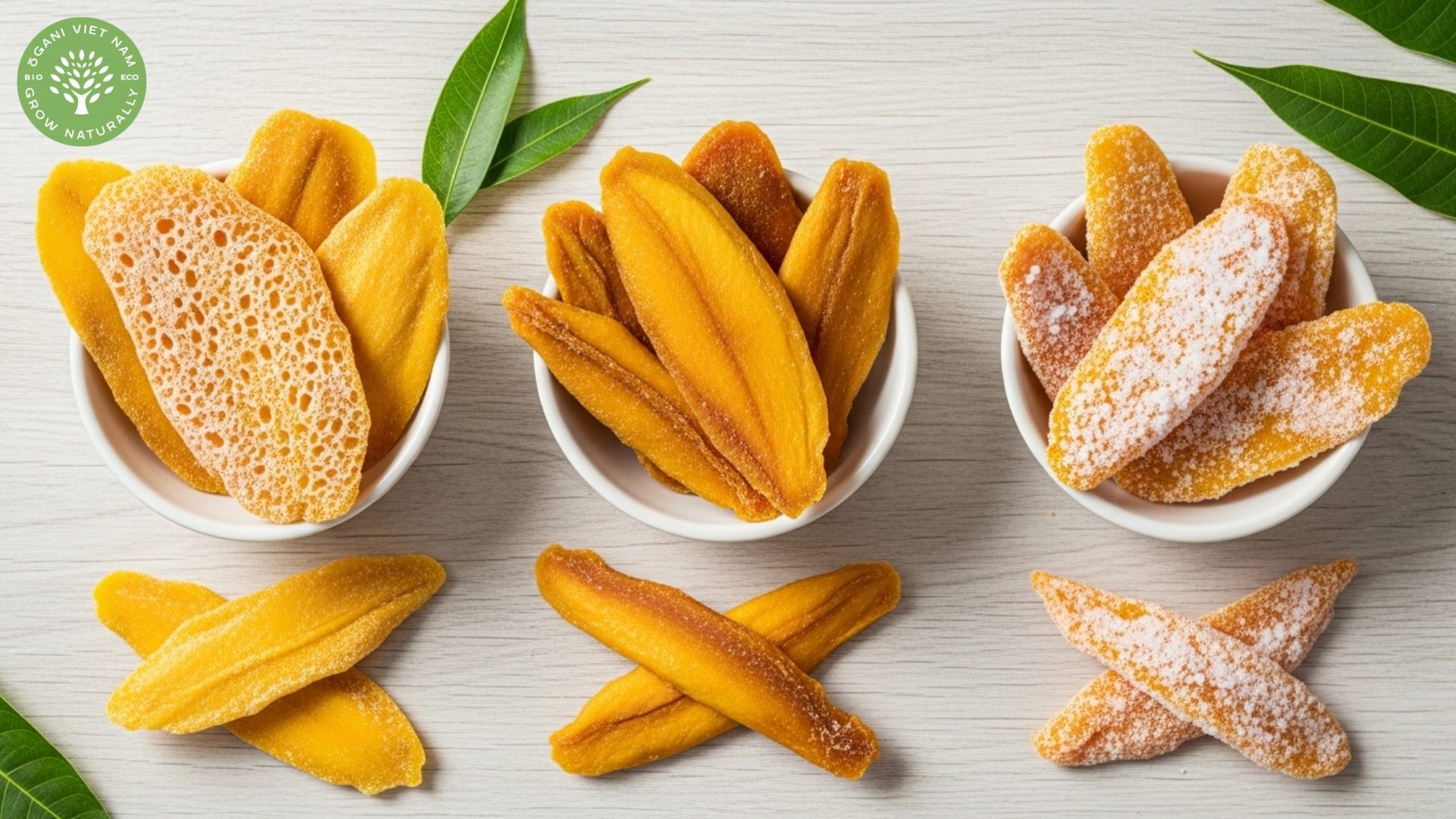Types of dried mango available in today’s market can feel overwhelming to choose from, which is why at Ogani VN, we’re here to simplify your decision. Simply put, there are three main categories: freeze-dried mango with its crispy texture, sun-dried mango offering traditional chewiness, and crystallized mango pieces providing extra sweetness.
Understanding different types of dried mango processing methods
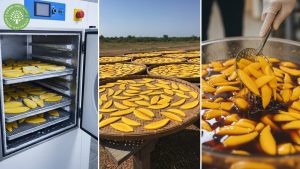
The method used to dry mangoes significantly impacts their final texture, nutritional value, and taste profile. Each technique has evolved over generations, from traditional sun-drying methods our grandmothers used to modern freeze-drying technology.
Freeze-dried mango
This modern preservation technique involves freezing fresh mango slices and then removing moisture through vacuum processing. The result? Incredibly crispy pieces that practically melt in your mouth. At Ogani VN, we’ve noticed customers often compare the texture to eating “mango chips” – light, airy, and satisfying with every crunch.
Sun-dried mango
The time-honored tradition of sun-drying creates those familiar chewy strips many of us grew up enjoying. Picture mangoes laid out on bamboo trays under the tropical sun, slowly concentrating their natural sugars. This method produces a denser, more filling snack that requires a bit more jaw work but delivers intense mango flavor.
Crystallized mango pieces
Here’s where things get interesting – and sweeter! Crystallized mangoes undergo a sugar-soaking process before drying, creating candy-like treats. Think of them as nature’s gummy bears, but with real fruit inside. While delicious, they’re definitely more of an occasional indulgence than an everyday snack.
Best mango varieties for creating quality types of dried mango
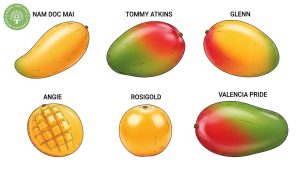
Not all mangoes dry equally well, something we learned through years of working with local farmers across Vietnam. The variety you choose dramatically affects the final product’s quality.
Nam Doc Mai mangoes, with their elongated shape and minimal fiber, excel in freeze-drying applications. Their naturally sweet flesh maintains structural integrity during the process. Meanwhile, Tommy Atkins mangoes – those larger, firmer fruits – work wonderfully for traditional sun-drying because their robust texture holds up well.
Glenn and Angie varieties fall somewhere in between, offering versatility for multiple drying methods. Interestingly, varieties like Rosigold and Valencia Pride, despite being delicious fresh, tend to lose their appeal when dried – becoming either too mushy or developing off-flavors.
Comparing nutritional values across types of dried mango
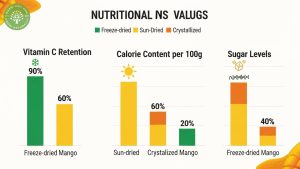
Understanding the nutritional differences between types of dried mango helps you make informed choices for your health goals. Let’s break down what happens to those precious nutrients during different drying processes.
Freeze-dried mangoes retain the highest vitamin content, preserving up to 90% of vitamin C and most water-soluble nutrients. The rapid freezing and vacuum process minimizes oxidation, keeping those immune-boosting properties intact. Sun-dried varieties lose more vitamins during their extended drying period but concentrate minerals like potassium and iron.
Crystallized mangoes, while undeniably tasty, pack significantly more calories due to added sugars. A 100-gram serving can contain double the calories of unsweetened versions. At Ogani VN, we always recommend checking labels carefully – some products marketed as “dried mango” actually contain surprising amounts of added sweeteners.
Texture and taste variations among types of dried mango
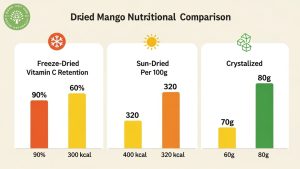
Every type of dried mango offers a unique sensory experience, and personal preference plays a huge role in finding your favorite. We’ve noticed customers often have strong opinions about texture – some can’t stand anything but ultra-crispy, while others crave that traditional chewiness.
The crispy spectrum
Freeze-dried mangoes deliver maximum crunch, almost dissolving on your tongue with a burst of concentrated flavor. They’re perfect for adding to cereals or yogurt without making things soggy. Some customers describe them as “astronaut food” – which isn’t far off, considering the technology!
The chewy tradition
Sun-dried and low-temperature dehydrated mangoes provide that satisfying chew many associate with childhood memories. They require more time to enjoy, making them ideal for mindful snacking. The texture varies from slightly pliable to quite firm, depending on moisture content and storage conditions.
The candy-like option
Crystallized pieces occupy their own category entirely. Coated in sugar crystals, they offer immediate sweetness followed by fruity mango notes. Kids especially love these, though we remind parents they’re more treat than health food.
Selecting the perfect types of dried mango for your lifestyle
Selecting among different types of dried mango depends on several factors: your intended use, dietary preferences, and storage capabilities. Let me share some practical guidance based on common customer questions at Ogani VN.
For healthy snacking and weight management, unsweetened freeze-dried or naturally sun-dried options work best. Their lower calorie density and absence of added sugars make portion control easier. Athletes and hikers often prefer the lightweight, nutrient-dense freeze-dried variety for easy energy on the go.
Baking enthusiasts should consider the moisture content carefully. Sun-dried mangoes work beautifully in breads and muffins, while freeze-dried pieces maintain their structure better in cookies and energy bars. Crystallized mangoes can replace candied fruit in traditional recipes – try them in your next batch of spring rolls for a modern twist!
Storage also matters. Freeze-dried mangoes stay crispy longest in airtight containers with moisture absorbers. Sun-dried varieties are more forgiving but can become too hard if over-dried or too soft in humid conditions. We always recommend buying smaller quantities more frequently rather than stockpiling, ensuring optimal freshness.
Frequently asked questions
Q: Which type of dried mango is healthiest? A: Unsweetened freeze-dried mango typically retains the most nutrients while adding no extra sugars. However, naturally sun-dried mango without additives runs a close second and offers beneficial fiber.
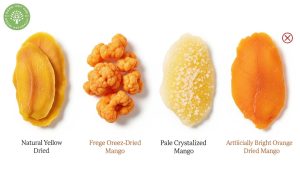
Q: Can diabetics eat dried mango? A: Small portions of unsweetened dried mango can fit into a diabetic diet, but the concentrated natural sugars require careful monitoring. Always consult your healthcare provider and check blood sugar responses.
Q: How long do different types of dried mango last? A: Properly stored freeze-dried mango can last 12-18 months, sun-dried varieties typically stay good for 6-12 months, while crystallized mangoes may last up to 2 years due to their sugar content.
Q: Why are some dried mangoes orange while others are yellow? A: Color depends on the mango variety and processing method. Natural variations are normal, but artificially bright colors might indicate added dyes – something we never use at Ogani VN.
Making the smart choice for your dried mango needs
Understanding various types of dried mango empowers you to make choices aligned with your taste preferences and health goals. Whether you prefer the modern crispness of freeze-dried, the traditional chew of sun-dried, or the indulgent sweetness of crystallized varieties, quality matters most. At Ogani VN, we’re committed to bringing you premium dried mangoes sourced directly from trusted local farmers. Ready to explore our selection? Visit our store today and discover your perfect dried mango match – your taste buds will thank you!
Read more:
- Is Organic Dried Mango Good For You? Health Benefits Revealed
- Best Dried Mango No Sugar Added: Premium Quality Guide
- Calories In Dried Mango No Sugar Added: Complete Nutrition Guide
- Are Dried Mangoes Good For You? The Complete Health Guide
- Types of Dried Mango: Your Complete Guide to Sweet Varieties


